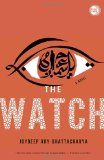Summary | Excerpt | Reviews | Beyond the Book | Read-Alikes | Genres & Themes | Author Bio

A Novel
by Joydeep Roy-BhattacharyaThis article relates to The Watch
The Greek classic, Antigone (written by Sophocles around 440 BC, based on the older Theban legend), serves as the basis for the modern-day Afghan war story, The Watch. Joydeep Roy-Bhattacharya makes no attempt to hide the fact and even invites comparisons, titling two chapters "Antigone" and "Ismene" after the two sisters in the tragedy. A lieutenant in the story lends the classic text to his captain, urging him to read it because "it's about as cogent an analysis as anything you'll find about where we are today." But how alike are the two works?
 Antigone and her siblings are the offspring of Oedipus and his mother/wife, Jocasta. Antigone's brothers take opposing sides in a power struggle over the throne of Thebes and kill each other, "each smitten by the other, each stained with a brother's blood." Creon, who ascends the throne after the death of Antigone's brothers, is also her uncle. Creon orders his dead ally buried, "crowned with every rite that follows the noblest dead to their rest." The brother who opposed him is left on the battlefield for everyone to see, "that none shall grace him with sepulture or lament, but leave him unburied, a corpse for birds and dogs to eat, a ghastly sight of shame." Creon forbids anyone to bury him under penalty of death. Antigone, who is betrothed to Creon's son, decides to bury her brother anyway. The king then has her sealed in a cave so she will starve, absolving him of direct responsibility for her death. Creon's son then takes his life in despair.
Antigone and her siblings are the offspring of Oedipus and his mother/wife, Jocasta. Antigone's brothers take opposing sides in a power struggle over the throne of Thebes and kill each other, "each smitten by the other, each stained with a brother's blood." Creon, who ascends the throne after the death of Antigone's brothers, is also her uncle. Creon orders his dead ally buried, "crowned with every rite that follows the noblest dead to their rest." The brother who opposed him is left on the battlefield for everyone to see, "that none shall grace him with sepulture or lament, but leave him unburied, a corpse for birds and dogs to eat, a ghastly sight of shame." Creon forbids anyone to bury him under penalty of death. Antigone, who is betrothed to Creon's son, decides to bury her brother anyway. The king then has her sealed in a cave so she will starve, absolving him of direct responsibility for her death. Creon's son then takes his life in despair.
 The parallels between the classic Antigone and Roy-Bhattacharya's The Watch are plain to see, though some similarities are metaphorical, while others are actual. Nizam's dead brother is left to be used by the "birds and dogs" of the government, and though Nizam is not sentenced to death, her actions could be construed as a de facto death sentence. Roy-Bhattacharya titles Nizam's narrative "Antigone," and that of the army's Tajik interpreter, Masood, "Ismene," the name of Antigone's sister. Masood understands Nizam's quest to recover her brother's body. However, he tries to reason with her to abandon her demands, just as Ismene tries to convince Antigone of her foolhardiness.
The parallels between the classic Antigone and Roy-Bhattacharya's The Watch are plain to see, though some similarities are metaphorical, while others are actual. Nizam's dead brother is left to be used by the "birds and dogs" of the government, and though Nizam is not sentenced to death, her actions could be construed as a de facto death sentence. Roy-Bhattacharya titles Nizam's narrative "Antigone," and that of the army's Tajik interpreter, Masood, "Ismene," the name of Antigone's sister. Masood understands Nizam's quest to recover her brother's body. However, he tries to reason with her to abandon her demands, just as Ismene tries to convince Antigone of her foolhardiness.
The structural similarities of the two tales also bear scrutiny. Antigone is a play and is confined to a particular framework; there is no narrator, the audience is aware of the characters' thoughts only through their voices. Roy-Bhattacharya uses the first-person narration of multiple characters to create a similar structure in his prose. However, his use of dream sequences allows us to enter the soldiers' psyches in a way that Sophocles' work cannot. Sophocles uses "choruses" to provide background on the drama and to serve as a pseudo-conscience for Creon and his subjects.
If you're interested in comparing the two texts for yourself, check out the free, online edition of Sophocles' Antigone at The Massachusetts Institute of Technology classics website, and then click here to read an excerpt of The Watch at BookBrowse.
Filed under Books and Authors
![]() This "beyond the book article" relates to The Watch. It originally ran in June 2012 and has been updated for the
March 2013 paperback edition.
Go to magazine.
This "beyond the book article" relates to The Watch. It originally ran in June 2012 and has been updated for the
March 2013 paperback edition.
Go to magazine.
Outside of a dog, a book is man's best friend. Inside of a dog it's too dark to read.
Click Here to find out who said this, as well as discovering other famous literary quotes!
Your guide toexceptional books
BookBrowse seeks out and recommends the best in contemporary fiction and nonfiction—books that not only engage and entertain but also deepen our understanding of ourselves and the world around us.